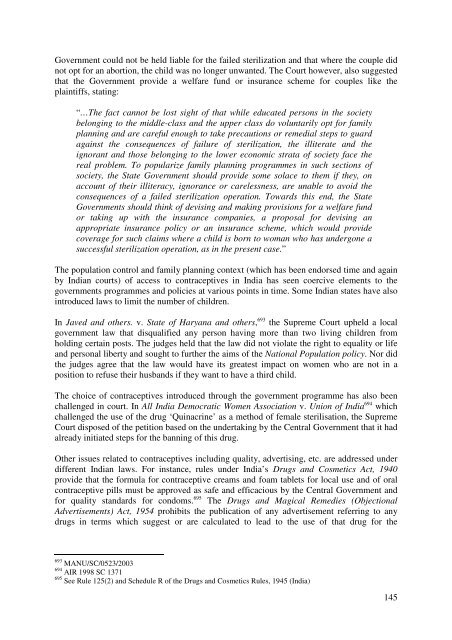SEXUAL HEALTH AND HUMAN RIGHTS A legal and ... - The ICHRP
SEXUAL HEALTH AND HUMAN RIGHTS A legal and ... - The ICHRP
SEXUAL HEALTH AND HUMAN RIGHTS A legal and ... - The ICHRP
You also want an ePaper? Increase the reach of your titles
YUMPU automatically turns print PDFs into web optimized ePapers that Google loves.
Government could not be held liable for the failed sterilization <strong>and</strong> that where the couple did<br />
not opt for an abortion, the child was no longer unwanted. <strong>The</strong> Court however, also suggested<br />
that the Government provide a welfare fund or insurance scheme for couples like the<br />
plaintiffs, stating:<br />
“…<strong>The</strong> fact cannot be lost sight of that while educated persons in the society<br />
belonging to the middle-class <strong>and</strong> the upper class do voluntarily opt for family<br />
planning <strong>and</strong> are careful enough to take precautions or remedial steps to guard<br />
against the consequences of failure of sterilization, the illiterate <strong>and</strong> the<br />
ignorant <strong>and</strong> those belonging to the lower economic strata of society face the<br />
real problem. To popularize family planning programmes in such sections of<br />
society, the State Government should provide some solace to them if they, on<br />
account of their illiteracy, ignorance or carelessness, are unable to avoid the<br />
consequences of a failed sterilization operation. Towards this end, the State<br />
Governments should think of devising <strong>and</strong> making provisions for a welfare fund<br />
or taking up with the insurance companies, a proposal for devising an<br />
appropriate insurance policy or an insurance scheme, which would provide<br />
coverage for such claims where a child is born to woman who has undergone a<br />
successful sterilization operation, as in the present case.”<br />
<strong>The</strong> population control <strong>and</strong> family planning context (which has been endorsed time <strong>and</strong> again<br />
by Indian courts) of access to contraceptives in India has seen coercive elements to the<br />
governments programmes <strong>and</strong> policies at various points in time. Some Indian states have also<br />
introduced laws to limit the number of children.<br />
In Javed <strong>and</strong> others. v. State of Haryana <strong>and</strong> others, 693 the Supreme Court upheld a local<br />
government law that disqualified any person having more than two living children from<br />
holding certain posts. <strong>The</strong> judges held that the law did not violate the right to equality or life<br />
<strong>and</strong> personal liberty <strong>and</strong> sought to further the aims of the National Population policy. Nor did<br />
the judges agree that the law would have its greatest impact on women who are not in a<br />
position to refuse their husb<strong>and</strong>s if they want to have a third child.<br />
<strong>The</strong> choice of contraceptives introduced through the government programme has also been<br />
challenged in court. In All India Democratic Women Association v. Union of India 694 which<br />
challenged the use of the drug ‘Quinacrine’ as a method of female sterilisation, the Supreme<br />
Court disposed of the petition based on the undertaking by the Central Government that it had<br />
already initiated steps for the banning of this drug.<br />
Other issues related to contraceptives including quality, advertising, etc. are addressed under<br />
different Indian laws. For instance, rules under India’s Drugs <strong>and</strong> Cosmetics Act, 1940<br />
provide that the formula for contraceptive creams <strong>and</strong> foam tablets for local use <strong>and</strong> of oral<br />
contraceptive pills must be approved as safe <strong>and</strong> efficacious by the Central Government <strong>and</strong><br />
for quality st<strong>and</strong>ards for condoms. 695 <strong>The</strong> Drugs <strong>and</strong> Magical Remedies (Objectional<br />
Advertisements) Act, 1954 prohibits the publication of any advertisement referring to any<br />
drugs in terms which suggest or are calculated to lead to the use of that drug for the<br />
693 MANU/SC/0523/2003<br />
694 AIR 1998 SC 1371<br />
695 See Rule 125(2) <strong>and</strong> Schedule R of the Drugs <strong>and</strong> Cosmetics Rules, 1945 (India)<br />
145

















